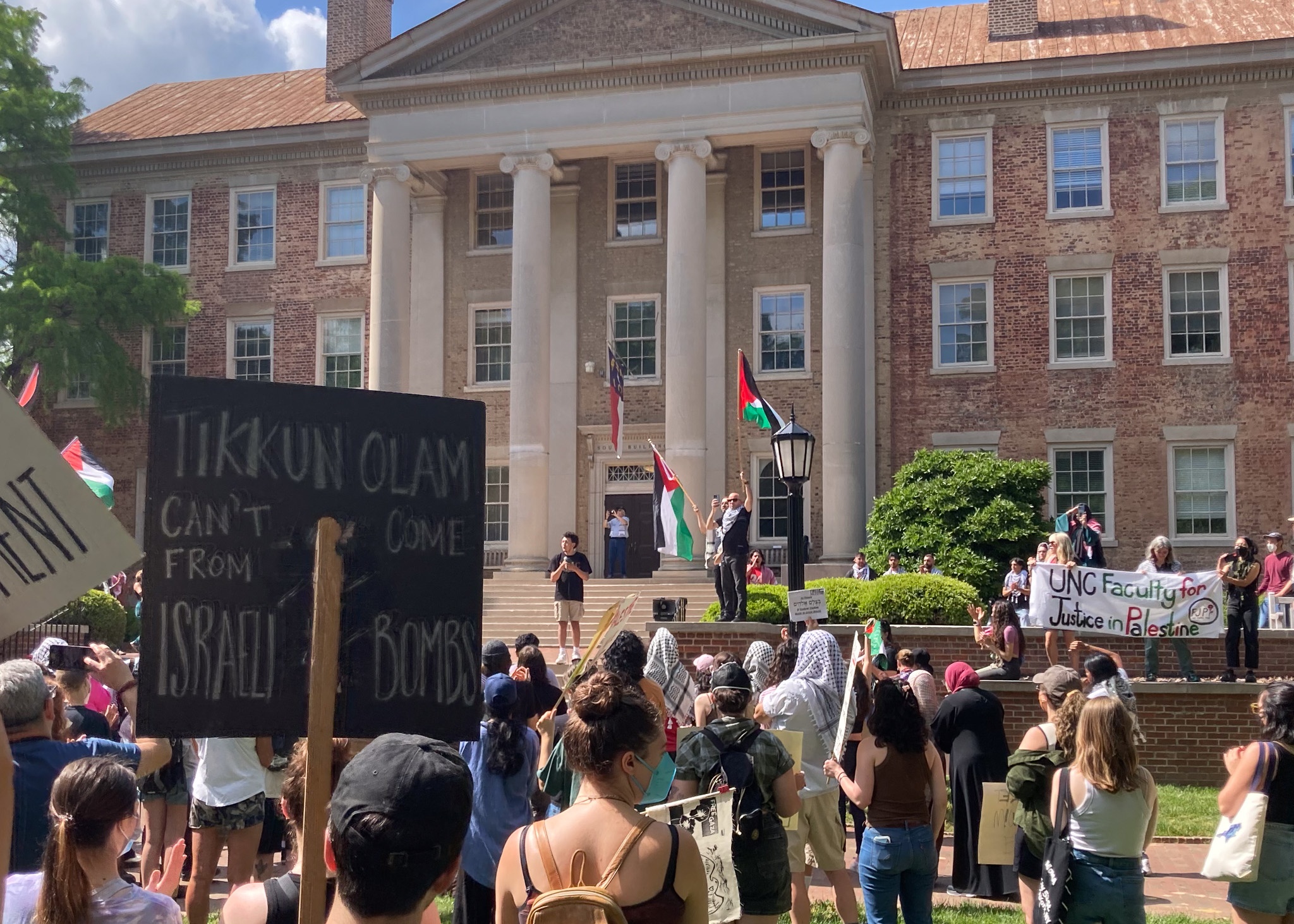A Southern Exposure/Facing South reading list for Gaza organizers

A rally in support of a pro-Palestinian student encampment at the University of North Carolina-Chapel Hill on April 28, 2024. (Image courtesy of Frankie Barrett)
Across the country, students have set up Gaza solidarity encampments, drawing attention to a campaign of violence that has cost more than 34,000 lives in Palestine over the last six months. These encampments follow months of students across the country pushing for their universities and schools to divest from U.S. militarism and to support Palestinian students and pro-Palestinian speech on campus.
In recent days, these protests have been met with state violence, with some of the most striking images coming from the South: lines of armed police marching across the quad at the University of Texas-Austin, arresting students at UNC, brutalizing and tear gassing them at Emory and VCU.
The South is no stranger to violent repression of protest. Movements for racial and social justice across the last three centuries have drawn state violence on a mass scale. But in their struggle and resistance, activists young and old have created a tradition of coalitions, models for solidarity, and tactics that can inform the current generation of protests. In service of understanding these protests in their long historical context, we have put together a reading list of stories from Southern Exposure and Facing South that may be valuable for current organizers protesting and researching U.S. and institutional funding of Israeli military action in Gaza. A chronological reading list is below.
Violence and Genocide, by Julian Bond and Leah Wise. In the opening essay to Southern Exposure’s first issue, Julian Bond and Leah Wise drew a clear line between the South’s militarism, its police, and the Vietnam War. (1973)
Julian Bond: The Movement, Then and Now, by Julian Bond, Bob Hall, and Sue Thrasher. In this wide-ranging oral history, Bond reflects on the early student civil rights movement, the strategies of the Greensboro sit-ins, and the civil rights and anti-war movements after the 1960s. (1975)
Greensboro Sit-ins, by Eugene Pfaff. In these 1981 oral histories with people involved in the historic 1960 Greensboro sit-ins, activists discuss the strategy and tactics employed by the student movements of the time. (1981)
Insurgent Memories, by Gwendolyn M. Patton. A student organizer at Tuskegee recalls her experiences facing down the National Guard and organizing within the HBCU in the 1960s. (1981)
Institute Special Report: The Third of November. This report on the 1979 Greensboro killing of five communist demonstrators by the Ku Klux Klan and Nazi party focuses in part on the police department’s role in the murders, and their interactions with white supremacists. (1981)
Missiles & Magnolias: The South at War. This issue of Southern Exposure focused on the South’s ensnaring in the politics, culture, and economy of U.S. militarism. Find the entire issue PDF here. (2002)
The South at war—in Gaza, by Chris Kromm. Amid a 2009 Israeli military onslaught on Gaza, Chris Kromm wrote about the Southern roots of U.S. arms supplied to Israel. (2009)
Making the global local: Southerners rally for Gaza peace, by Desiree Evans. Thousands of activists across the South joined anti-war protests in 2009. This piece catalogues their locations and demands. (2009)
INSTITUTE INDEX: The military program that’s equipping police like an occupying military force, by Sue Sturgis. A by-the-numbers look at the federal programs that have helped militarize police forces across the country. (2014)
‘Honk for humane jobs’: NC activists challenge subsidies for weapons maker, by Taylor Barnes. In 2021, North Carolinians pushed back against a Raytheon plant proposed to be built in Asheville, which was set to make parts for F-35 jets that were used by the IDF in campaigns that killed hundreds of people in Gaza. (2021)
Tags
Olivia Paschal
Olivia Paschal is the archives editor with Facing South and a Ph.D candidate in history at the University of Virginia. She was a staff reporter with Facing South for two years and spearheaded Poultry and Pandemic, Facing South's year-long investigation into conditions for Southern poultry workers during the COVID-19 pandemic. She also led the Institute's project to digitize the Southern Exposure archive.
